I love cooking at home and always want to learn more. For years, I wondered about the rule against mixing shrimp and chicken. Is it really a safety issue, or just an old wives’ tale? In this guide, we’ll look into this mystery and share important facts for food lovers.
Main Highlights
- Explore the safety and culinary aspects of combining shrimp and chicken in dishes.
- Learn about food handling practices, cooking techniques, and nutritional considerations for these popular proteins.
- Discover expert insights on proper preparation methods and debunk common myths surrounding seafood and poultry combinations.
- Understand the importance of cross-contamination prevention and safe food handling guidelines.
- Discover alternative protein combinations for balanced and delicious meals.
Understanding Food Combination Safety in Modern Cuisine
In the world of cooking, knowing how to mix foods safely is key. Chefs and home cooks use many ingredients. They must focus on food safety, culinary hygiene, and kitchen practices to make tasty, healthy meals.
Many people worry about mixing seafood, like shrimp, with poultry, like chicken. But, the truth is, following food handling and preparation techniques is what matters. By sticking to food safety rules, cooks can enjoy exploring new recipes with these proteins.
Food safety is all about keeping food at the right temperature and avoiding contamination. Foods like seafood and poultry need careful handling. If not, harmful bacteria can grow, causing sickness.
| Food Safety Statistic | Significance |
|---|---|
| An estimated 1.3 billion tons of edible food is lost and wasted yearly, according to the Food and Agricultural Organization (FAO). | Proper food handling and storage practices can help reduce food waste and ensure food safety. |
| TCS foods are more prone to bacterial growth, which can lead to foodborne illnesses if not handled and stored properly. | Understanding the unique characteristics of TCS foods and implementing appropriate handling techniques are crucial for maintaining food safety. |
| Foodborne illness outbreaks caused by consuming contaminated TCS foods can have a significant economic impact on businesses and the food industry. | Adhering to food safety guidelines helps protect both consumers and the food industry from the adverse consequences of foodborne illnesses. |
By following food safety rules, cooks can make delicious meals with seafood and poultry. They can create tasty, healthy dishes that are good for everyone.
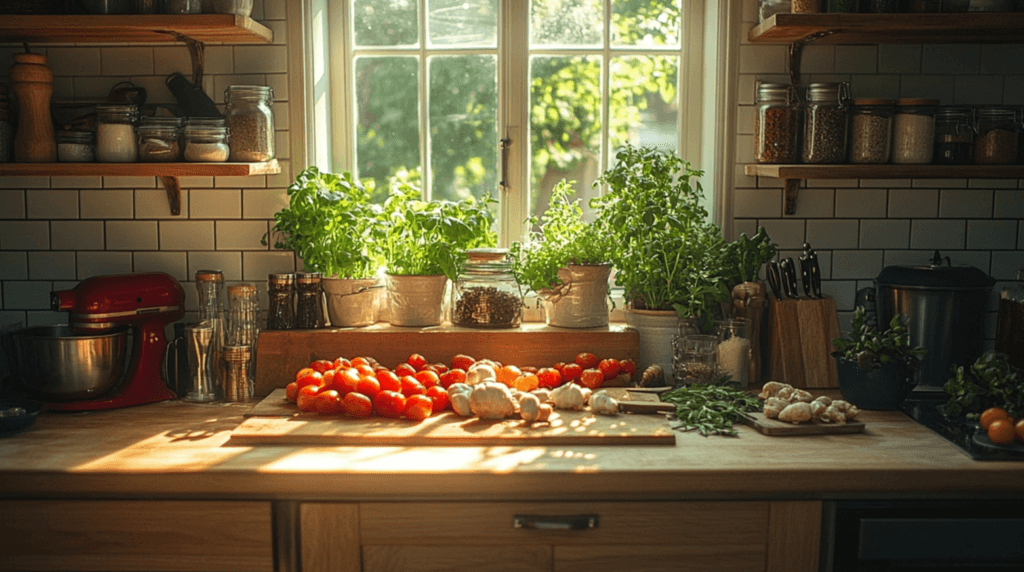
Do not combine shrimp with chicken?
Many think mixing shrimp and chicken is bad. They worry it might cause food poisoning. But, science and cooking worldwide show it’s okay.
Common Misconceptions About Mixing Seafood and Poultry
People think shrimp and chicken can’t be together because of cooking times. But, if you cook them right, it’s safe. The main worry is getting food dirty, which you can prevent.
Scientific Evidence on Combined Protein Sources
Many studies prove it’s safe to eat shrimp and chicken together. Dishes like Chicken and Shrimp Stir-Fry and Chicken and Shrimp Fried Rice are popular. Just make sure they’re cooked well.
Cultural Perspectives on Food Combinations
Shrimp and chicken are often paired in many cuisines. They’re in Asian stir-fries and Caribbean rice dishes. This shows it’s okay to mix them.
In short, mixing shrimp and chicken is not a problem. With the right cooking and care, they make great dishes together. This gives us tasty and healthy meals.
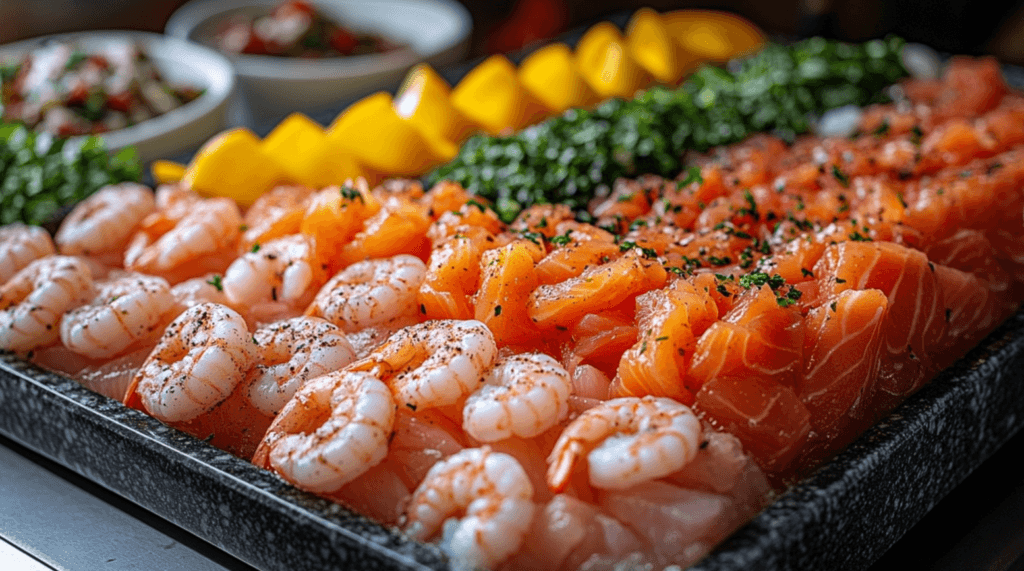
Cross-Contamination Risks in Kitchen Practices
Keeping your kitchen clean and preventing cross-contamination is key to making safe meals. Food poisoning happens when harmful bacteria move from one food to another. This can be very serious, especially for kids, the elderly, and those with weak immune systems.
Handling different proteins like seafood and poultry in the same kitchen is a big challenge. If not done right, it can spread dangerous bacteria like Salmonella and E. coli. This risks your family’s health.
- Use separate cutting boards, utensils, and areas for raw chicken and seafood to avoid cross-contamination.
- Clean and sanitize all surfaces, equipment, and hands before and after handling different proteins. This stops harmful bacteria from spreading.
- Keep raw chicken and seafood in separate spots in the fridge. This helps prevent juices or residues from mixing and contaminating other foods.
Following good kitchen practices is vital for food safety. It keeps your family safe from foodborne illnesses. By being careful about cross-contamination and taking the right steps, you can make many tasty and healthy meals. This way, you can keep your family’s health and well-being first.
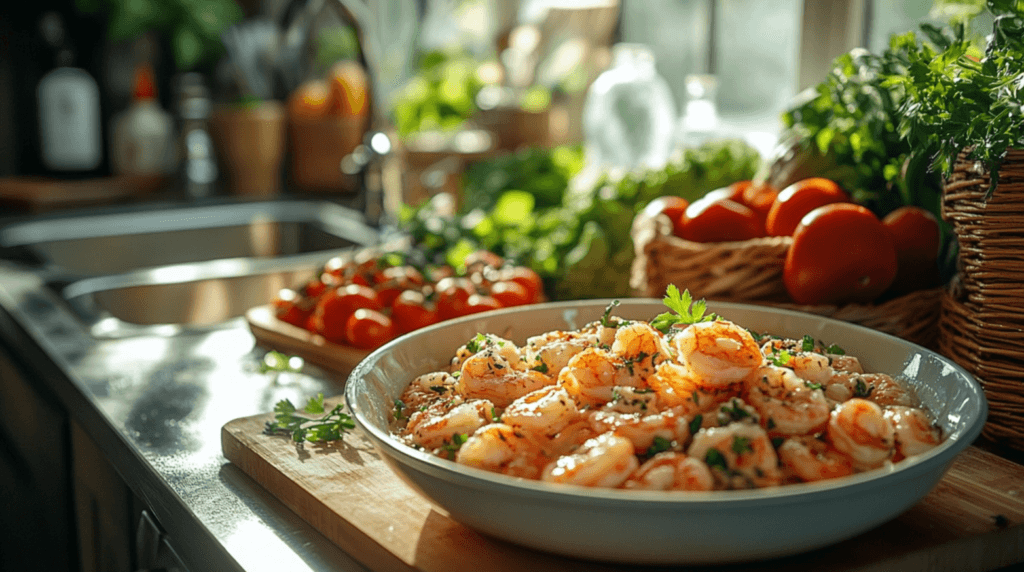
Safe Food Handling Guidelines for Seafood and Poultry
Keeping food safe is very important, especially with seafood and poultry. Use the right storage, control the temperature, and keep areas separate. This helps avoid food sickness and contamination. Here are the key steps to keep your food safe and tasty.
Proper Storage Techniques
Storing food right is the first step in keeping it safe. Keep raw seafood and poultry cold, below 40°F (4°C). Freeze items you won’t use soon to make them last longer. Always keep raw foods away from cooked or ready-to-eat foods to stop contamination.
Temperature Control Methods
Temperature is key in food safety. Keep the temperature steady when cooking seafood and poultry. Thaw frozen foods in the fridge, not at room temperature. Cook seafood to 145°F (63°C) and poultry to 165°F (74°C) to kill bacteria.
Separate Preparation Areas
It’s crucial to have separate areas for different foods. Use different cutting boards, knives, and tools for each. Clean and sanitize everything well after use to avoid spreading germs.
By following these guidelines, you can enjoy seafood and poultry safely. Food safety is always the most important thing in the kitchen.
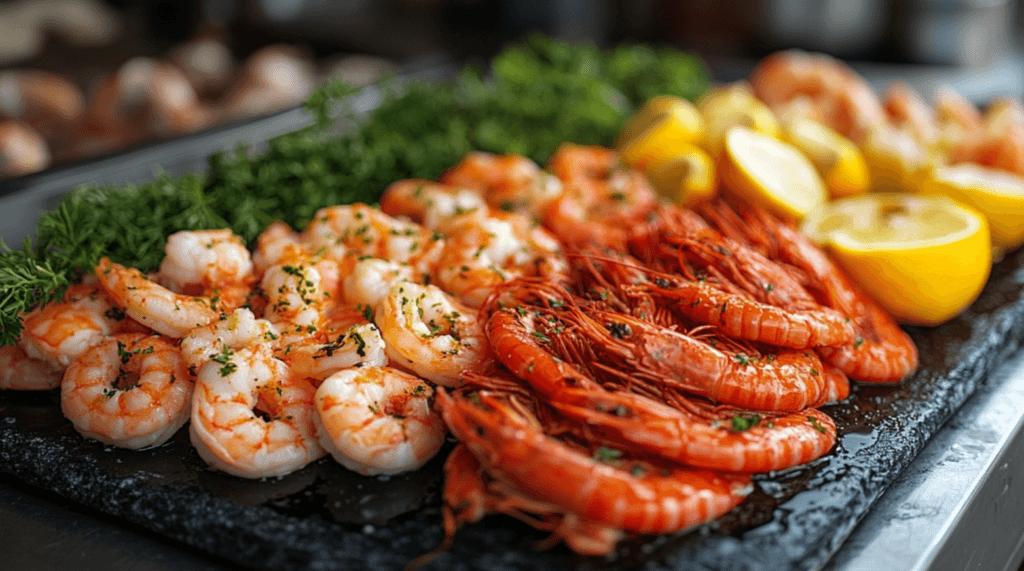
Health Benefits and Nutritional Considerations
Shrimp and chicken together make a great diet. Shrimp is full of protein, vitamins, and omega-3s. Chicken adds more protein and nutrients to your meals.
Shrimp has almost 9 grams of protein in 10 medium pieces. It’s also low in mercury, good for pregnant women and kids. Shrimp also has iodine, important for your thyroid.
Eating shrimp and chicken can make your diet balanced. Shrimp helps lower heart disease risk with its omega-3s. Chicken is lean protein that helps muscles grow.
Mixing shrimp and chicken in your meals is healthy. It makes your meals nutritious and supports your health. Always cook safely to keep your food and family healthy.
| Nutrient | Shrimp (10 medium cooked) | Chicken Breast (3 oz cooked) |
|---|---|---|
| Calories | 45.5 | 165 |
| Protein (g) | 8.7 | 31 |
| Fat (g) | 0.7 | 3.6 |
| Carbohydrates (g) | 0 | 0 |
| Omega-3 Fatty Acids (g) | 0.08 | 0.12 |
| Iodine (mcg) | 13 | 2 |
Professional Kitchen Standards for Handling Multiple Proteins
In the culinary world, keeping food safe and clean is key. This is especially true when working with seafood and poultry. Professional kitchens must follow strict rules to keep customers safe and meet high food safety standards.
Commercial Kitchen Guidelines
Commercial kitchens have to follow health rules to stop cross-contamination. These rules include:
- Keeping seafood and poultry at the right temperatures. Seafood should be at 45°F or lower, and poultry at 40°F or below.
- Having separate areas for different proteins to avoid mixing.
- Cleaning and sanitizing all tools and surfaces well.
Food Service Safety Protocols
Food service places also have to follow strict safety rules. These rules are to keep customers safe. They include:
- Storing seafood and poultry right to keep them fresh and stop bacteria growth.
- Cooking seafood and poultry to the right temperature to kill harmful germs.
- Training employees well on food safety, like washing hands and using gloves.
Equipment Sanitation Requirements
Keeping kitchen equipment clean is very important. It helps prevent cross-contamination and keeps food safe. Commercial kitchens must follow strict cleaning rules for their equipment, including:
| Equipment | Sanitation Requirement |
|---|---|
| Cutting boards | Cleaning and sanitizing after each use, with separate boards for seafood and poultry |
| Knives and utensils | Washing and sanitizing after each use, with dedicated tools for seafood and poultry |
| Preparation surfaces | Cleaning and sanitizing before and after use, with designated areas for seafood and poultry |
By following these standards, commercial places can handle multiple proteins safely. This ensures the highest food safety, culinary hygiene, and kitchen practices for their customers.
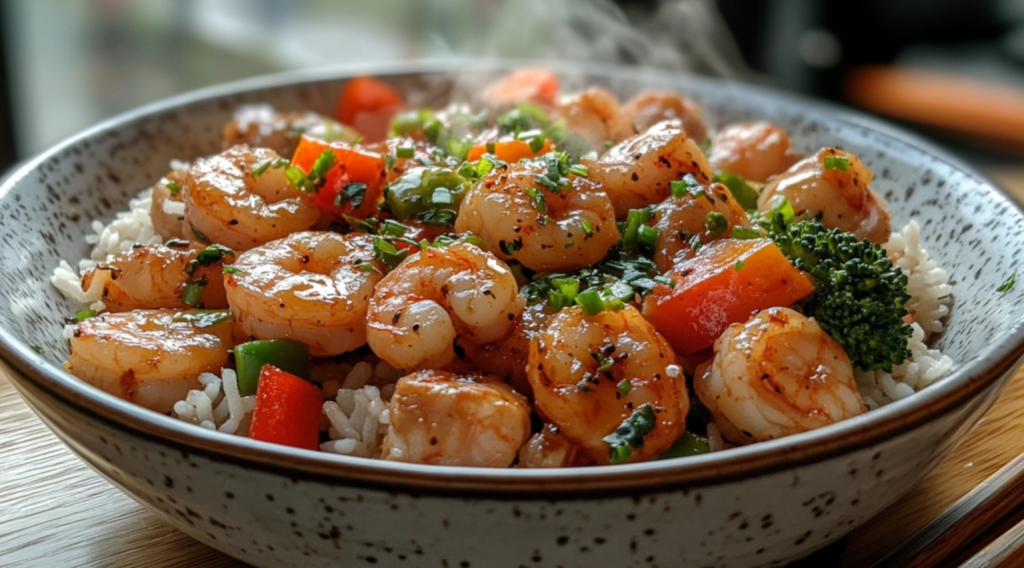
Safe Cooking Temperatures and Times
Keeping food safe is key, especially with proteins like shrimp and chicken. Knowing the right cooking temperatures and times is crucial. This ensures your food is not only tasty but also safe to eat.
Shrimp should be cooked between 135–140°F (57–60°C) for juiciness. The USDA says to cook shrimp to 145°F (63°C) for safety. When grilling, use 15-20 count shrimp and cook for about 5 minutes. A pinch of baking soda can help with browning.
Letting shrimp dry in the fridge for 1 hour before cooking is also important. This step helps with grilling or searing.
Chicken needs to be cooked to 165°F (74°C) to kill harmful bacteria. Use a food thermometer to check the chicken’s internal temperature. This is the only sure way to know if it’s cooked right.
By following these guidelines, you can make sure your shrimp and chicken dishes are both tasty and safe to eat.
| Ingredient | Optimal Cooking Temperature | Cooking Time |
|---|---|---|
| Shrimp | 135-140°F (57-60°C) | About 5 minutes |
| Chicken | 165°F (74°C) | Varies based on cooking method |
Alternative Protein Combinations for Balanced Meals
Exploring different protein combinations can change your diet. You don’t have to stick to just shrimp and chicken. There are many tasty and healthy options that are good for you.
Seafood Pairing Options
Seafood is a great protein source. Try pairing shrimp with quinoa, lentils, or chickpeas for a protein-rich meal. Salmon with roasted veggies and brown rice makes a quick, nutritious dinner. Seafood offers endless meal options.
Poultry Combination Suggestions
- Swap ground meat for lentils in your favorite shepherd’s pie recipe.
- Use cauliflower “rice” as a low-carb grain substitute.
- Choose bean patties for a tasty veggie burger.
- Make a high-protein one-pot meal with chicken sausage and beans.
- Try almond flour for a crunchy chicken cutlet coating.
These protein combinations are not only nutritious but also add variety to your meals. They make your food exciting and satisfying.
| Protein Source | Grams of Protein per Serving |
|---|---|
| Chicken | 15 grams |
| Lentils | 18 grams |
| Quinoa | 18 grams |
| Shrimp | 20 grams |
| Salmon | 22 grams |
By trying these protein combinations, you can make balanced and tasty meals. They meet your dietary needs and support your health and well-being.
Best Practices for Home Meal Preparation
Preparing meals at home is rewarding and saves money. It helps you eat healthy and balanced. When using proteins like shrimp and chicken, follow key steps for safe and tasty meals.
Meal planning is key. Plan your meals for the week. Note down the proteins, veggies, and other items you need. This saves time and cuts down on waste and grocery trips.
- Prioritize meal preparation on designated “meal prep” days, such as Sundays or Wednesdays, to set aside dedicated time for cooking and portioning out your meals.
- Invest in airtight storage containers to keep your prepped ingredients and meals fresh for up to 4 days in the refrigerator.
- Label and date your containers to ensure you consume the oldest items first and avoid any food safety issues.
Handling proteins like shrimp and chicken safely is important. Use separate areas, boards, and tools for each to avoid contamination. Also, make sure to cook them well to keep them safe to eat.
| Protein | Safe Internal Temperature |
|---|---|
| Shrimp | 145°F (63°C) |
| Chicken | 165°F (74°C) |
By following these tips, you can enjoy the benefits of meal prep safely and healthily. Try new protein and flavor combinations to keep your meals exciting.
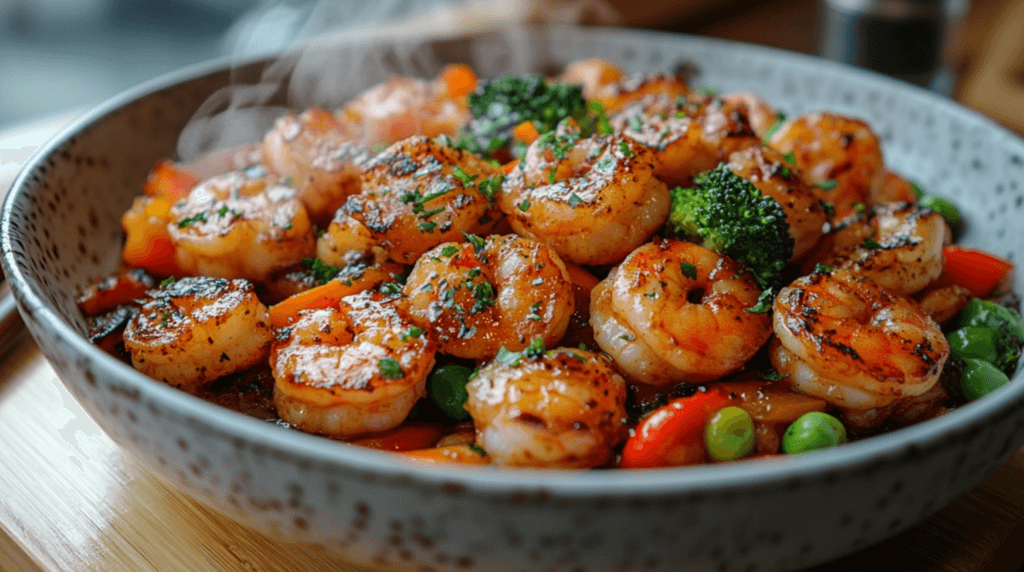
Food Safety Myths vs. Facts
There are many myths about food safety, especially with seafood and poultry. It’s important to know the truth to keep our meals safe and healthy. Let’s look at some common myths.
Myth: You should never combine shrimp with chicken or other poultry. Fact: There’s no proof that eating shrimp and chicken together is harmful. They can be safely mixed in a meal if cooked right.
Myth: Mixing seafood and poultry leads to cross-contamination and increased foodborne illness. Fact: Any raw protein can cause cross-contamination. But, following good food handling and cooking methods can prevent this.
Myth: Certain food combinations are inherently unsafe and should be avoided. Fact: Food safety depends on how you prepare, store, and cook it, not what you mix. By following safety guidelines, you can enjoy many protein-rich dishes.
To keep food safe, always wash your hands, keep raw and cooked foods separate, and cook proteins to the right temperature. Also, store perishable items correctly. By doing this, you can safely mix shrimp, chicken, and other proteins in your cooking.
| Food Safety Myth | Fact |
|---|---|
| Combining shrimp and chicken is unsafe. | There is no scientific evidence that this combination poses significant health risks when handled and cooked properly. |
| Mixing seafood and poultry leads to cross-contamination. | Cross-contamination can occur with any raw protein. Proper food handling and cooking techniques are key to prevention. |
| Certain food combinations are inherently unsafe. | The safety of food combinations depends on preparation, storage, and cooking, not the specific ingredients. |
By debunking these myths and following best practices, you can enjoy a wide variety of protein-rich dishes. This way, you can make sure your meals are healthy and safe.
Conclusion
Shrimp and chicken together in meals are not unsafe, despite what some think. Knowing the science and following food safety rules helps make tasty, healthy meals. These meals can have different proteins.
Keeping food safe is key when cooking, no matter the ingredients. Use safe storage, keep food at the right temperature, and use separate areas for each food. This stops food from getting mixed up and keeps everyone healthy.
Trying new protein mixes can lead to exciting dishes. You can mix seafood with poultry or make dishes with just poultry. This way, you can make meals that everyone likes and that are good for them. By following these tips, you can enjoy shrimp, chicken, and more while keeping food safety, meal preparation, and cooking guidelines in mind.
FAQ
Can you combine shrimp and chicken in the same dish?
Yes, you can mix shrimp and chicken in one dish. Just make sure to handle and cook them safely.
Is it safe to mix shrimp and chicken?
Yes, mixing shrimp and chicken is safe if done right. Use separate tools and areas for each raw protein to avoid contamination.
What are the risks of combining shrimp and chicken?
Mixing shrimp and chicken can lead to contamination. But, with proper handling and cooking, there’s no inherent danger.
How do I prevent cross-contamination when cooking shrimp and chicken together?
To avoid contamination, use different cutting boards and tools for each protein. Wash your hands well after touching each. Cook both to the right temperature.
What are the recommended cooking temperatures for shrimp and chicken?
Cook shrimp to 145°F (63°C) and chicken to 165°F (74°C). A food thermometer helps ensure they’re cooked safely.
Are there any nutritional benefits to combining shrimp and chicken in a dish?
Yes, mixing shrimp and chicken offers a good mix of proteins and nutrients. It can make a meal both nutritious and tasty.
Are there any cultural or culinary traditions that involve combining shrimp and chicken?
Yes, many cultures mix shrimp and chicken in dishes like stir-fries and pasta. Just remember to cook and handle them safely.

